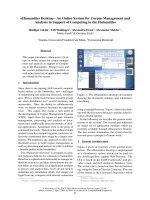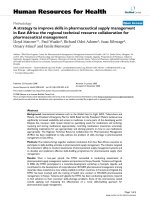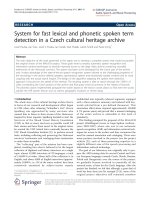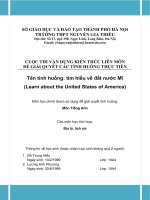learn about the international certification system for the logistics and scm choose a certification and build a strategy to achieve the certification system
Bạn đang xem bản rút gọn của tài liệu. Xem và tải ngay bản đầy đủ của tài liệu tại đây (590 KB, 32 trang )
<span class="text_page_counter">Trang 1</span><div class="page_container" data-page="1">
<b>ĐẠI HỌC DUY TÂN</b>
<b>VIỆN QUẢN LÝ NAM KHUÊ</b>
<b>BÁO CÁO ĐỒ ÁN KẾT THÚC HỌC PHẦNMÔN HƯỚNG NGHIỆP 2</b>
ĐỀ TÀI:
<b>LEARN ABOUT THE INTERNATIONAL CERTIFICATION SYSTEMFOR THE LOGISTICS AND SCM, CHOOSE A CERTIFICATION ANDBUILD A STRATEGY TO ACHIEVE THE CERTIFICATION SYSTEM.GVHD: NGUYỄN THỊ MAI DIỆU</b>
</div><span class="text_page_counter">Trang 2</span><div class="page_container" data-page="2">CHAPTER I: OVERVIEW OF THEORETICAL BASE...9
<b>1.1. Overview of logistics industry and supply chain management 9...9</b>
<b>1.1.1. Definition of logistics...9</b>
<b>1.1.2. Definition of Supply Chain...11</b>
<b>1.1.3. Components of a Supply Chain...12</b>
<b>1.1.4. Definition of Supply Chain Management...13</b>
<b>1.2. Overview of international certification in the industry...14</b>
</div><span class="text_page_counter">Trang 3</span><div class="page_container" data-page="3"><b>1.3.2. Time and Resource Strategy:...16</b>
CHAPTER II: INFORMATION COLLECTION AND PROCESSING METHODS ...17
<b>2.1. Method of collecting information:...17</b>
<b>2.1.1. Online information...17</b>
<b>2.1.2. Information from original documents...18</b>
<b>2.1.3. Information from other sources...20</b>
<b>2.2. Information processing...20</b>
CHAPTER III: ACHIEVED RESULTS...21
<b>3.1. Similarities and differences between logistics and scm...21</b>
<b>3.1.1. Supply chain management versus logistics...21</b>
<b>3.1.2. How are supply chain management and logistics similar?...21</b>
<b>3.1.3. How are supply chain management and logistics different?...22</b>
<b>3.1.4. The main differences between logistics and supply chain management include:...22</b>
<b>3.2. Benefits and effects of certificates...23</b>
<b>3.3. Introduction to the system of international certifications in logistics and supply chain management...24</b>
<b>3.3.1. cscp certificate...24</b>
3
</div><span class="text_page_counter">Trang 4</span><div class="page_container" data-page="4"><b>3.3.2. Fiata certificate...26</b>
<b>3.3.3. scpro certificate...27</b>
<b>3.4. Understand more about cscp certification...28</b>
<b>3.4.1. Why should you get cscp certification...28</b>
<b>3.4.2. What does a cscp certificate do for you?...29</b>
<b>3.4.3. Benefits of getting cscp certification...29</b>
<b>3.5. Plan and implementation strategy to achieve the certificate...30</b>
<b>3.5.1. Planning...30</b>
<b>3.5.2. Implementation of the strategy...30</b>
WORK DISTRIBUTION TABLE...32
</div><span class="text_page_counter">Trang 5</span><div class="page_container" data-page="5"><b>To: Ms. Nguyen Thi Dieu Mai</b>
First of all we would like to express our sincere gratitude to you. During our <b>,</b>
studies, you have shown great care, support and dedicated guidance. Thanks to your instructions, we have gained a better understanding of the role and importance of the logistics and supply chain industry, which enabled us to complete this essay. This essay is the result of our group's research and learning process. However, due to limitations in terms of resources, abilities, and knowledge, there may be some unavoidable errors in the essay. We hope to receive your sincere understanding and feedback, as well as from our classmates, in order to improve our work.
<b>We sincerely thank you!</b>
5
</div><span class="text_page_counter">Trang 6</span><div class="page_container" data-page="6">LIST OF ACRONYMS
SCM: Supply Chain Management ( Quản lí chuỗi cung ứng)CSCP: Certified Supply Chain Frofessional ( Chứng chỉ quản lý chuỗi cung ứng chuyên nghiệp)
CPIM: Certified in Production and Inventory Management ( Chứng chỉ về lập kế hoạch và quản lí hàng tồn kho)
CLTD: Certified in Logistics, Transportation and Distribution ( Chứng chỉ trong logistics, vận tải và phân phối)
CPSM: Certified Professional in Supply Management ( Chứng chỉ chuyên nghiệp trong quản lý nguồn cung ứng)
CSCMP: Council of Supply Chain Management Professionals (Hội đồng chuyên nghiệp ưu việt của các chuyên gia quản lý chuỗi cung ứng trên toàn thế giới)
EDGE: Enhanced Data Rates for GSM Evolution), đôi khi cịn gọi là Enhanced GPRS (EGPRS) (cơng nghệ di động được nâng cấp từ GPRS)
ERP : Enterprise Resource Planning (Hệ thống giúp hoạch định nguồn lực của doanh nghiệp)
</div><span class="text_page_counter">Trang 7</span><div class="page_container" data-page="7">Introduction Paragraph
Along with the development of the global economy and the increasing trend of globalization, the global market is becoming increasingly sensitive to time issues as well as competition in terms of price and quality of service. Besides, there is the rapid development of information technology and strict requirements in the management of materials and components. In response to these practical requirements, Logistics services were born and developed. Logistics service is a "total package" process from planning, organizing and implementing to controlling goods... to the final consumer, aiming to satisfy customer requirements quickly, safely, continuously and efficiently at low cost.
With such an important role, the Logistics industry is now becoming more and more popular and chosen by many students in recent years When Logistics <b>.</b>
companies open, employers will not simply look for workers to work for them, but their deeper goal is to find high-quality talents. Therefore, the job requirements in the industry are very high and they also require their candidates to provide the certificates they want. This will help them have access to a large and high-quality source of human resources to work in the enterprise.
Logistics certificates are certificates related to the Logistics industry or related industries. By adding Logistics certificates, especially international certificates to the job application, they increase their competitiveness compared to other candidates. Through that, it will affirm that the individual applying for a Logistics job is competent and shows that they are a person with deep professional knowledge in the field.
In general, Logistics certificates are extremely important documents for Logistics job seekers to pursue their dreams. This is a document for them to assert
7
</div><span class="text_page_counter">Trang 8</span><div class="page_container" data-page="8">themselves, increase their value and help each individual have a foothold in their career. Therefore, learning and providing Logistics certificates is essential. Because those certificates play an important role for each individual and are also a great potential for employers, our group decided to choose the topic: "Studying the international certification system for the Logistics and SCM industry, choosing 1 certificate and building a strategy to achieve the certification system". It not only provides the necessary information for each individual in this field to better understand how to achieve the certificate.
</div><span class="text_page_counter">Trang 9</span><div class="page_container" data-page="9">CHAPTER I: OVERVIEW OF THEORETICAL BASE
<b>1.1. Overview of logistics industry and supply chain management 91.1.1. Definition of logistics</b>
<b>Origin and Definition:</b>
The term "logistics" originates from the ancient Greek word "logistikos", meaning the art of calculation. Initially, it was used in the military context, referred to as "logistics", meaning providing necessities from the rear to the front line. The Oxford English Dictionary defines logistics as a branch of military science dealing with the procurement, maintenance, and transportation of materiel, personnel, and equipment. Other dictionaries define logistics as the timely and efficient arrangement of resources.
<b>Application and Importance:</b>
Logistics is increasingly applied in various economic sectors globally to address the issue of economic efficiency as human needs grow but resources and raw materials for production are limited. Therefore, logistics services have been and are developing strongly to serve business activities for optimal efficiency, producing products with the best quality and the least cost.
<b>Core Activities:</b>
The essence of logistics activities is the integration of management activities of the flow of goods and materials from the place of production to the place of consumption and to the hands of consumers. In the chain of activities of logistics services, transportation is the main business activity, so sometimes some people
9
</div><span class="text_page_counter">Trang 10</span><div class="page_container" data-page="10">believe that logistics is a goods transportation activity, a multimodal transportation type.
<b>Various Definitions:</b>
According to the United Nations, logistics is the activity of managing the movement of materials through storage, production into products, and to consumers according to customer requirements.
According to the Logistics Management Council, logistics is a part of the supply chain process that includes planning, organizing, implementing, controlling, and monitoring the efficient movement and storage of goods, services, and related information from the point of origin to points of consumption to meet customer requirements.
From the WTO's perspective, Logistics is defined as a service supply chain, including planning, implementing, and controlling the movement and storage of goods, services, and related information from the place of production to the place of consumption to meet customer requirements. Traditional logistics services include transportation, warehousing, forwarding, and third-party value-added services (such as working according to customer requirements).
According to the previous terminology, the Law on Commerce in 1997 of Vietnam called logistics services as freight forwarding services and was regulated as follows: "Freight forwarding service is a commercial act, in which, the freight forwarder receives goods from the sender, organizes transportation, warehousing, storage, paperwork, and other related services to deliver goods to the consignee at the request of the cargo owner, the carrier, or another freight forwarder (hereinafter referred to as the customer)".
</div><span class="text_page_counter">Trang 11</span><div class="page_container" data-page="11">In the Law on Commerce in 2005, for the first time, Vietnamese law included regulations on logistics services in legal documents, according to Article 233 of the Law on Commerce in 2005:
"Logistics service is a commercial activity in which a trader organizes and performs one or more tasks including receiving goods, transporting, storing, storing, clearing customs, other paperwork, consulting customers, packing, coding, delivering goods or other services related to goods as agreed with the customer to receive remuneration".
With many concepts as above, logistics services are understood in a broad and narrow sense as follows:
In the narrow sense, logistics services are associated with the entire process of importing raw materials and materials as input for the production process, producing goods, and putting them into distribution channels to reach the final consumer.
In a broad sense, the essence of logistics services is to gather support factors for the process of transporting products from the place of production to the place of consumption.
Thus, the concept of logistics services in Vietnam is understood in a narrow sense, considered to be similar to a freight forwarding activity. However, it is also necessary to recognize that the definition in the Law on Commerce in 2005 is open, which is the regulation: "or other services related to goods". Accordingly, in addition to the services listed in the law, traders can also do business in other services related to goods that can also belong to logistics service business.
<b>1.1.2. Definition of Supply Chain</b>
A supply chain is a system that links businesses from the production, processing, and packaging stages to distribution and final consumption. It includes
11
</div><span class="text_page_counter">Trang 12</span><div class="page_container" data-page="12">all activities and processes involved in the production and distribution of a product from raw materials to the end customer. It is a network of companies and organizations that work together to produce and deliver goods and services to customers. The supply chain is one of the most important concepts in business today and has a major impact on the development and competitiveness of businesses.
<b>1.1.3. Components of a Supply Chain</b>
A complete supply chain is built from many different parts. All of these parts work together to get a product from the raw material supplier to the end customer. Specifically, a supply chain consists of 5 basic components: raw material suppliers, manufacturers, distributors, retailers, and customers.
<small></small> <b>Raw Material Suppliers: These are the entities that provide the raw </b>
materials to produce the finished product. Raw material suppliers play an important role in the supply chain, as without raw materials, it is impossible to produce the final product.
<small></small> <b>Manufacturers: The manufacturer is the entity that produces the finished </b>
product from the raw materials provided by the raw material supplier. The manufacturer plays an important role in converting raw materials into finished products.
<small></small> <b>Distributors: After the finished product is manufactured, the distributor will</b>
be responsible for distributing the product to retailers. Distributors play an important role in creating the link between manufacturers and retailers.
<small></small> <b>Retailers: These are the entities that sell the finished product to the end </b>
customer. Retailers will buy the product from the distributor or manufacturer and sell it to individual customers. Retailers include convenience
stores, supermarkets, and grocery stores.
</div><span class="text_page_counter">Trang 19</span><div class="page_container" data-page="19">In the current context of globalization, logistics plays an important role, contributing to promoting economic development. However, in Vietnam, the law regulating logistics services is not really complete, and there are still shortcomings that limit the competitiveness of businesses.
According to many Logistics experts, our country has a relatively complete legal system regulating logistics services. However, there are still limitations in the uniformity and clarity of legal documents. The interpretation and application of provisions of the law on logistics activities have many inconsistencies, causing difficulties for businesses when implementing them. exam.
Therefore, the Government and relevant ministries and branches are making every effort to perfect the legal system to regulate and create conditions for logistics services to develop and improve competitiveness. In 2022, the Government and the Ministry of Transport have issued many important legal documents on Logistics. For example, the Government issued Decree No. 64/2022/ND-CP dated September 15, 2022 amending and supplementing a number of articles of Decrees related to business activities in the field of civil aviation. use. Decree No. 64/2022/ND-CP dated September 15, 2022 amending and
supplementing a number of Decrees related to business activities in the field of civil aviation: Decree No. 68/2015/ ND-CP dated August 18, 2015 regulates nationality registration and registration of rights to aircraft; Decree No.
92/2016/ND-CP dated July 1, 2016 regulating conditional business lines in the field of civil aviation and Decree No. 89/2019/ND-CP dated November 15 /2019 amends and supplements a number of articles of Decree 92/2016/ND-CP; Decree No. 05/2021/ND-CP dated January 25, 2021 on management and operation of airports and aerodromes.
19
</div><span class="text_page_counter">Trang 20</span><div class="page_container" data-page="20"><b>2.1.3. Information from other sources</b>
Also known as public information. There are many other types of information sources that we can refer to, but the level of reliability is not as high as sources from original documents or online articles. These sources of information can come from interviews with individuals, related organizations, seminars discussing logistics topics or short videos spread on logistics and supply chain management forums, etc. Sources This information is often very easy to absorb, concise and easy to understand, but accuracy is not guaranteed, so it is necessary to select and verify carefully before using.
<b>2.2. Information processing</b>
Data processing is the method of collecting raw data and converting it into usable information. After collection, data undergoes filtering, sorting, processing, analysis, storage, and is then presented in a readable format.
Information processing has the role of analyzing and interpreting data to help you understand problems and make informed decisions. Effective information processing involves many steps, including organizing and structuring data, identifying patterns and trends, and drawing meaningful conclusions.
Through different sources of information, we will have a lot of information and from there, arrange and select the information and choose the appropriate information source to gather the necessary information for us.
</div>








